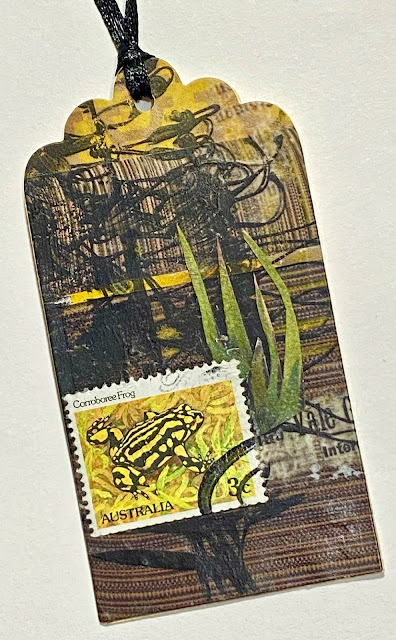For the Tag Tuesday theme " Animals, Wild or Tame ( no insects" , I made two small tags, both with my favourite collage material - postage stamps.
For the first one , I chose an Australian stamp , issued in 1982 , rasing the awareness of the endangered corroboree frog. Here is some information about it....
Corroboree Frogs are Australia’s most iconic amphibian species and amongst the most visually spectacular frogs in the world. They can be readily distinguished by the bold yellow and black longitudinal stripes on its top, sides and legs. Its belly is marbled black, white and yellow. Both the males and females have the same colouration but females are slightly larger than males.
These frogs are found in marshlands and sclerophyll forests under logs, and subalpine bogs of south-eastern NSW and the ACT. Catching a glimpse of these stunning creatures is a rare and exciting occurrence. They are largely nocturnal but are also occasionally active during the day on cloudy days.
From high altitude bogs and swamps, the male Corroboree will call to the female during mating season (January – February). This song that is more like a ‘squelch’ begins the life-cycle of these tiny amphibians. (from https://www.taronga.org.au/animals/corroboree-frog)
The second tag is a Hong Kong stamp issued in 2007, to mark the Lunar New Year and the Year of the Pig - a much favoured animal in the Chinese Zodiac ... With a round and fat face, the Pig is the symbol of wealth, felicity, honesty, and practicality in Chinese zodiac culture. Many money pots (Chinese piggybanks) are made pig-shaped as people believe Pig invocation will bring good luck monetarily.
Of course, pigs have been more maligned in the wild state in Hong Kong - perhaps you have seen reports like this in the news.
Hong Kong authorities have captured and euthanised seven wild boars as they began a campaign to reduce their numbers in urban areas around the financial centre after one bit a policeman last week.About 30 boar attacks have been reported in recent years, authorities said.Hong Kong’s policy had been to capture the animals, then sterilise and relocate them to remote, unpopulated areas.The city is home to about 3,000 wild boars, according to government data, and they are not a protected species. Boar have at times been seen on subway trains, or waiting for the traffic light to turn green at pedestrian crossings by the harbour... ( from https://www.theguardian.com/world/2021/nov/18/hong-kong-begins-hunting-wild-boar-amid-public-safety-fears )



Wonderful styled and creative tag art ~ Xo
ReplyDeleteWishing you laughter and love in your day,
A ShutterBug Explores,
aka (A Creative Harbor)
Both of your tags are perfect for our challenge, beautifully crafted.
ReplyDeleteThank you so much for joining us at Tag Tuesday x
Both tags are just gorgeous, so beautifully put together! Thanks for joining us at tag Tuesday this week.
ReplyDeletePinky